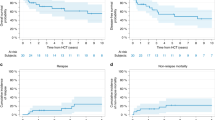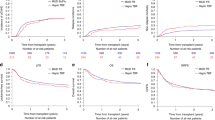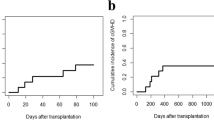Abstract
Fanconi anemia (FA) is a genomic instability syndrome associated with bone marrow failure, myelodysplastic syndrome (MDS), and/or acute myeloid leukemia (AML) requiring hematopoietic stem cell transplantation (HSCT) to restore normal hematopoiesis. Although low-intensity fludarabine-based preparative regimens without radiation confer excellent outcomes in FA HSCTs with HLA-matched sibling donors, outcomes for FA patients with alternative donors are less encouraging, albeit improving. We present our experience with 17 FA patients who completed mismatched related or unrelated donor HSCT using a non-radiation fludarabine-based preparative regimen at Charité University Medicine Berlin. All patients engrafted; however, one patient had unstable chimerism in the setting of multi-viral infections that necessitated a stem cell boost to revert to full donor chimerism. Forty-seven percent of patients developed grade I acute graft-verus-host disease (aGVHD). No grade II–IV aGVHD or chronic graft-versus-host disease of any severity occurred. At a median follow-up of 30 months, 88 % of patients are alive with normal hematopoiesis. Two patients died of infections 4 months post-transplantation. These results demonstrate that short-term outcomes for FA patients with mismatched and unrelated donor HSCTs can be excellent using chemotherapy only conditioning. Viral reactivation, however, was a major treatment-related complication.


Similar content being viewed by others
References
Berger R, Bernheim A, Gluckman E et al (1980) In vitro effect of cyclophosphamide metabolites on chromosomes of Fanconi anaemia patients. Br J Haematol 45(4):565–568
Auerbach AD, Adler B, O'Reilly RJ et al (1983) Effect of procarbazine and cyclophosphamide on chromosome breakage in Fanconi anemia cells: relevance to bone marrow transplantation. Cancer Genet Cytogenet 9(1):25–36
Gluckman E, Devergie A, Dutreix J (1983) Radiosensitivity in Fanconi anaemia: application to the conditioning regimen for bone marrow transplantation. Br J Haematol 54(3):431–440
Guardiola P, Socie G, Li X et al (2004) Acute graft-versus-host disease in patients with Fanconi anemia or acquired aplastic anemia undergoing bone marrow transplantation from HLA-identical sibling donors: risk factors and influence on outcome. Blood 103(1):73–77. doi:10.1182/blood-2003-06-2146
Gluckman E, Berger R, Dutreix J (1984) Bone marrow transplantation for Fanconi anemia. Semin Hematol 21(1):20–26
Kapelushnik J, Or R, Slavin S et al (1997) A fludarabine-based protocol for bone marrow transplantation in Fanconi's anemia. Bone Marrow Transplant 20(12):1109–1110. doi:10.1038/sj.bmt.1701016
Bitan M, Or R, Shapira MY et al (2006) Fludarabine-based reduced intensity conditioning for stem cell transplantation of Fanconi anemia patients from fully matched related and unrelated donors. Biol Blood Marrow Transplant 12(7):712–718. doi:10.1016/j.bbmt.2006.03.002
Tan PL, Wagner JE, Auerbach AD et al (2006) Successful engraftment without radiation after fludarabine-based regimen in Fanconi anemia patients undergoing genotypically identical donor hematopoietic cell transplantation. Pediatr Blood Cancer 46(5):630–636. doi:10.1002/pbc.20538
Wagner JE, Eapen M, MacMillan ML et al (2007) Unrelated donor bone marrow transplantation for the treatment of Fanconi anemia. Blood 109(5):2256–2262. doi:10.1182/blood-2006-07-036657
Drobyski WR (2000) Evolving strategies to address adverse transplant outcomes associated with T cell depletion. J Hematother Stem Cell Res 9(3):327–337
Guardiola P, Pasquini R, Dokal I et al (2000) Outcome of 69 allogeneic stem cell transplantations for Fanconi anemia using HLA-matched unrelated donors: a study on behalf of the European Group for Blood and Marrow Transplantation. Blood 95(2):422–429
Ayas M, Al-Seraihi A, El-Solh H et al (2012) The Saudi experience in fludarabine-based conditioning regimens in patients with Fanconi anemia undergoing stem cell transplantation: excellent outcome in recipients of matched related stem cells but not in recipients of unrelated cord blood stem cells. Biol Blood Marrow Transplant 18(4):627–632. doi:10.1016/j.bbmt.2011.08.015
Ayas M, Al-Jefri A, Al-Seraihi A et al (2008) Matched-related allogeneic stem cell transplantation in Saudi patients with Fanconi anemia: 10 year's experience. Bone Marrow Transplant 42(Suppl 1):S45–S48. doi:10.1038/bmt.2008.114
MacMillan ML, Wagner JE (2010) Haematopoeitic cell transplantation for Fanconi anaemia: when and how? Br J Haematol 149(1):14–21. doi:10.1111/j.1365-2141.2010.08078.x
Pasquini R, Carreras J, Pasquini MC et al (2008) HLA-matched sibling hematopoietic stem cell transplantation for Fanconi anemia: comparison of irradiation and nonirradiation containing conditioning regimens. Biol Blood Marrow Transplant 14(10):1141–1147. doi:10.1016/j.bbmt.2008.06.020
MacMillan ML, Blazar BR, Defor TE et al (2012) Alternative donor hematopoietic cell transplantation for patients with Fanconi anemia. ASH Ann Meet Abstr 120(21):3081
Bisset LR, Lung TL, Kaelin M et al (2004) Reference values for peripheral blood lymphocyte phenotypes applicable to the healthy adult population in Switzerland. Eur J Haematol 72(3):203–212. doi:10.1046/j.0902-4441.2003.00199.x
Przepiorka D, Weisdorf D, Martin P et al (1995) 1994 Consensus conference on acute GVHD grading. Bone Marrow Transplant 15(6):825–828
Filipovich AH, Weisdorf D, Pavletic S et al (2005) National Institutes of Health consensus development project on criteria for clinical trials in chronic graft-versus-host disease: I. Diagnosis and staging working group report. Biol Blood Marrow Transplant 11(12):945–956. doi:10.1016/j.bbmt.2005.09.004
Dignan FL, Amrolia P, Clark A et al (2012) Diagnosis and management of chronic graft-versus-host disease. Br J Haematol 158(1):46–61. doi:10.1111/j.1365-2141.2012.09128.x
Dignan FL, Clark A, Amrolia P et al (2012) Diagnosis and management of acute graft-versus-host disease. Br J Haematol 158(1):30–45. doi:10.1111/j.1365-2141.2012.09129.x
Aker M, Varadi G, Slavin S et al (1999) Fludarabine-based protocol for human umbilical cord blood transplantation in children with Fanconi anemia. J Pediatr Hematol Oncol 21(3):237–239
Shimoni A, Hardan I, Shem-Tov N et al (2006) Allogeneic hematopoietic stem-cell transplantation in AML and MDS using myeloablative versus reduced-intensity conditioning: the role of dose intensity. Leukemia 20(2):322–328. doi:10.1038/sj.leu.2404037
Blaise DP, Michel Boiron J, Faucher C et al (2005) Reduced intensity conditioning prior to allogeneic stem cell transplantation for patients with acute myeloblastic leukemia as a first-line treatment. Cancer 104(9):1931–1938. doi:10.1002/cncr.21418
Boulad F, Davies SM, Williams DA et al (2012) Chemotherapy-Only Preparative Regimen for T-Cell Depleted Hematopoietic Stem Cell Transplantation of Patients with Fanconi Anemia From Alternative Donors. Paper presented at the 54th ASH Annual Meeting and Exposition, Atlanta, GA, December 8-11
Stepensky P, Shapira MY, Balashov D et al (2011) Bone marrow transplantation for Fanconi anemia using fludarabine-based conditioning. Biol Blood Marrow Transplant 17(9):1282–1288. doi:10.1016/j.bbmt.2011.01.001
Djuzenova C, Flentje M, Plowman PN (2004) Radiation response in vitro of fibroblasts from a Fanconi anemia patient with marked clinical radiosensitivity. Strahlenther Onkol 180(12):789–797. doi:10.1007/s00066-004-1250-1
Deeg HJ, Socie G, Schoch G et al (1996) Malignancies after marrow transplantation for aplastic anemia and Fanconi anemia: a joint Seattle and Paris analysis of results in 700 patients. Blood 87(1):386–392
Rosenberg PS, Socie G, Alter BP et al (2005) Risk of head and neck squamous cell cancer and death in patients with Fanconi anemia who did and did not receive transplants. Blood 105(1):67–73. doi:10.1182/blood-2004-04-1652
Ayas M, Siddiqui K, Al-Jefri A et al (2014) Factors affecting the outcome of related allogeneic hematopoietic cell transplantation in patients with Fanconi anemia. Biol Blood Marrow Transplant. doi:10.1016/j.bbmt.2014.06.016
Peffault de Latour R, Porcher R, Dalle JH et al (2013) Allogeneic hematopoietic stem cell transplantation in Fanconi anemia: the European Group for Blood and Marrow Transplantation experience. Blood 122(26):4279–4286. doi:10.1182/blood-2013-01-479733
Koehl U, Bochennek K, Zimmermann SY et al (2007) Immune recovery in children undergoing allogeneic stem cell transplantation: absolute CD8+ CD3+ count reconstitution is associated with survival. Bone Marrow Transplant 39(5):269–278. doi:10.1038/sj.bmt.1705584
Chakrabarti S, Mackinnon S, Chopra R et al (2002) High incidence of cytomegalovirus infection after nonmyeloablative stem cell transplantation: potential role of Campath-1H in delaying immune reconstitution. Blood 99(12):4357–4363
Geddes M, Storek J (2007) Immune reconstitution following hematopoietic stem-cell transplantation. Best Pract Res Clin Haematol 20(2):329–348. doi:10.1016/j.beha.2006.09.009
Ayas M, Solh H, Mustafa MM et al (2001) Bone marrow transplantation from matched siblings in patients with Fanconi anemia utilizing low-dose cyclophosphamide, thoracoabdominal radiation and antithymocyte globulin. Bone Marrow Transplant 27(2):139–143. doi:10.1038/sj.bmt.1702754
Poire X, van Besien K (2011) Alemtuzumab in allogeneic hematopoietic stem cell transplantation. Expert Opin Biol Ther 11(8):1099–1111. doi:10.1517/14712598.2011.592824
Perlingeiro Beltrame M, Malvezzi M, Bonfim C et al (2014) Immune reconstitution in patients with Fanconi anemia after allogeneic bone marrow transplantation. Cytotherapy 16(7):976–989. doi:10.1016/j.jcyt.2014.02.015
Chakraverty R, Orti G, Roughton M et al (2010) Impact of in vivo alemtuzumab dose before reduced intensity conditioning and HLA-identical sibling stem cell transplantation: pharmacokinetics, GVHD, and immune reconstitution. Blood 116(16):3080–3088. doi:10.1182/blood-2010-05-286856
Kanda J, Lopez RD, Rizzieri DA (2011) Alemtuzumab for the prevention and treatment of graft-versus-host disease. Int J Hematol 93(5):586–593. doi:10.1007/s12185-011-0802-2
Soiffer RJ, Lerademacher J, Ho V et al (2011) Impact of immune modulation with anti-T-cell antibodies on the outcome of reduced-intensity allogeneic hematopoietic stem cell transplantation for hematologic malignancies. Blood 117(25):6963–6970. doi:10.1182/blood-2011-01-332007
Marsh JC, Pearce RM, Koh MB et al (2014) Retrospective study of alemtuzumab vs ATG-based conditioning without irradiation for unrelated and matched sibling donor transplants in acquired severe aplastic anemia: a study from the British Society for Blood and Marrow Transplantation. Bone Marrow Transplant 49(1):42–48. doi:10.1038/bmt.2013.115
Gandhi S, Kulasekararaj AG, Mufti GJ et al (2013) Allogeneic stem cell transplantation using alemtuzumab-containing regimens in severe aplastic anemia. Int J Hematol 97(5):573–580. doi:10.1007/s12185-013-1333-9
Acknowledgments
We thank all the referring centers for entrusting their patients to our care. MMC is supported by the Deutsche Kinderkrebsstiftung. For the analyses of clonal chromosome aberrations, HN received grants from the Deutsche Fanconi Anämie Hilfe e.V. and the Fanconi Anemia Research Fund. The GEFA Registry is supported by the Deutsche Fanconi Anämie Hilfe e.V.
Conflict of interest
The authors declare that they have no conflict of interest.
Author information
Authors and Affiliations
Corresponding author
Rights and permissions
About this article
Cite this article
Chao, M.M., Kuehl, J.S., Strauss, G. et al. Outcomes of mismatched and unrelated donor hematopoietic stem cell transplantation in Fanconi anemia conditioned with chemotherapy only. Ann Hematol 94, 1311–1318 (2015). https://doi.org/10.1007/s00277-015-2370-7
Received:
Accepted:
Published:
Issue Date:
DOI: https://doi.org/10.1007/s00277-015-2370-7




